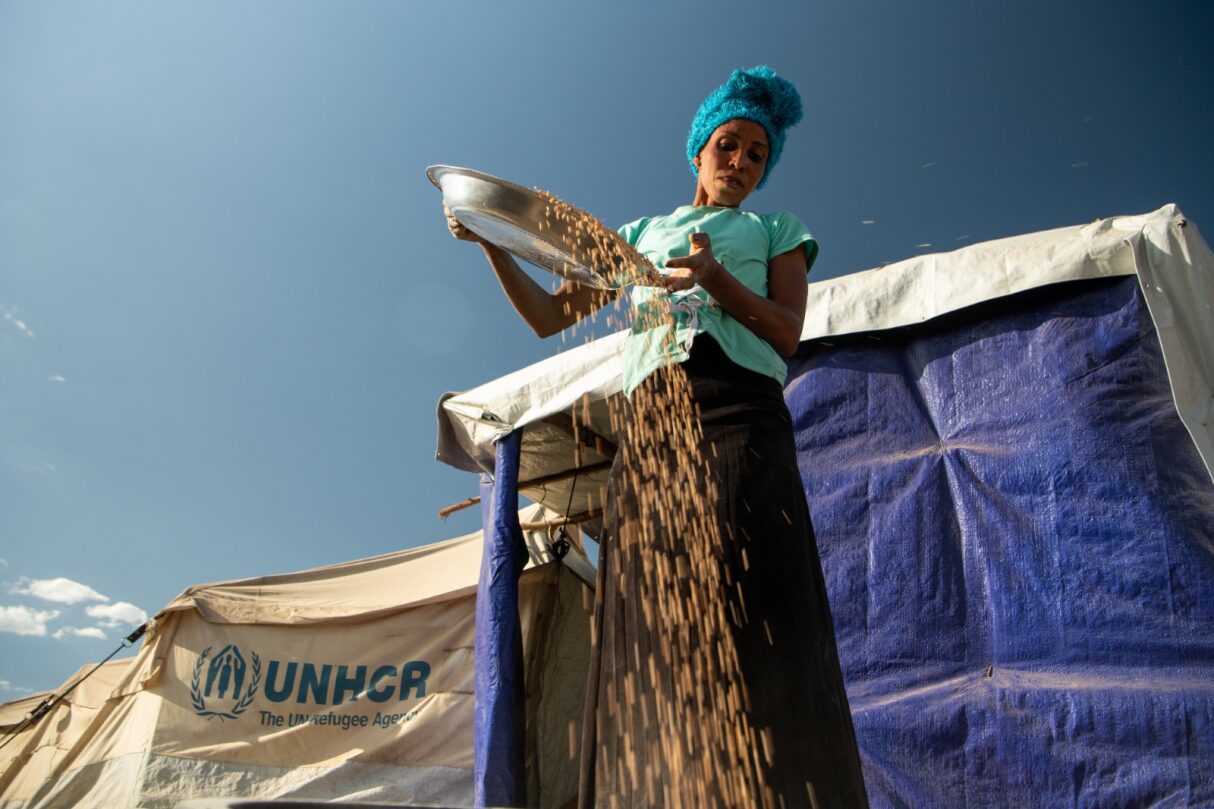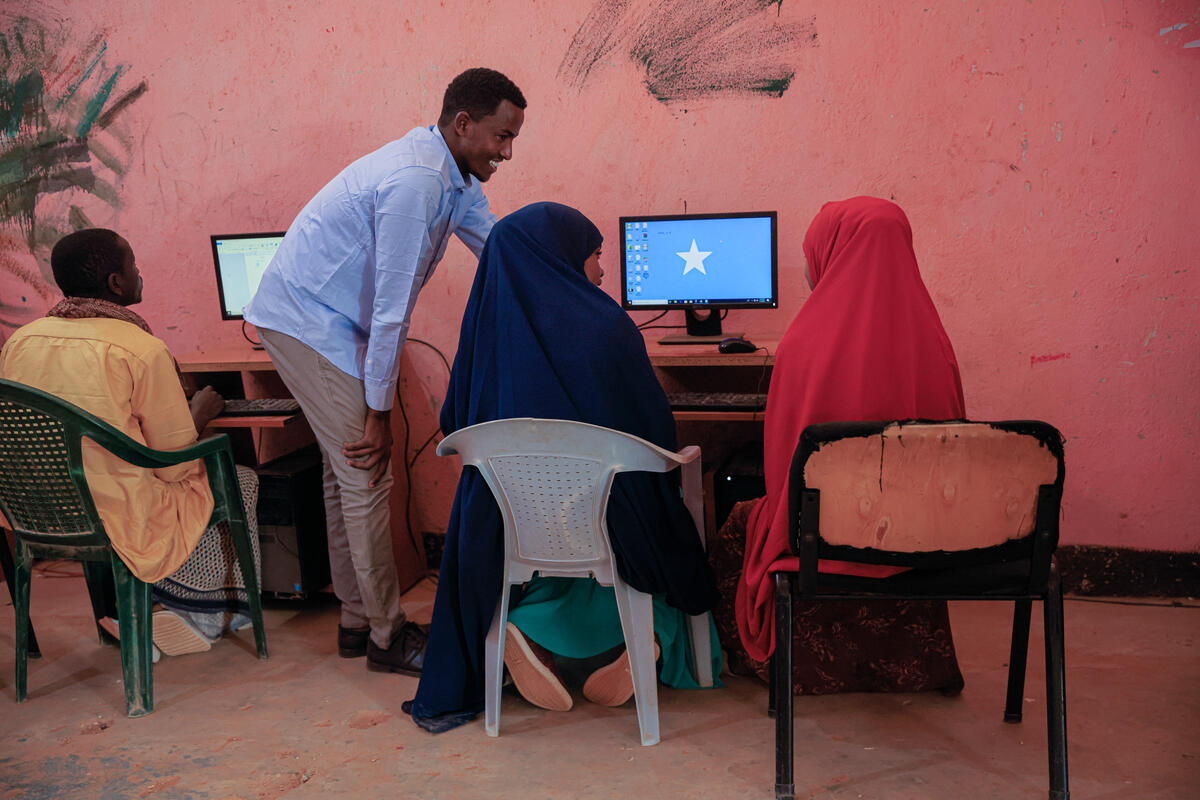Displaced people in Mozambique’s Cabo Delgado plead for peace
Displaced people in Mozambique’s Cabo Delgado plead for peace
By Hélène Caux in Mueda and Palma

Eduarte Cristiano Tumbati (red shirt), 38, poses with his family in Lianda IDP site. The family fled their village of Ntoli, Mueda district, when Eduarte's brother was killed by non-state armed groups.
In Mozambique’s northern Cabo Delgado province, every day is a fight for survival. For the past seven years, people have endured violent attacks and witnessed their loved ones being killed, mutilated, and raped, and their homes and businesses burned to the ground. Men and boys have been forcibly recruited into non-state armed groups (NSAGs). Girls and women have been kidnapped and used as sex slaves. Livelihoods have been destroyed, and access has been cut off to basic necessities such as food, healthcare and education.
As of January 2024, over 582,000 were still displaced in northern Mozambique, due to recurring attacks on civilians and governmental forces by NSAGs since 2017. At the height of the conflict in 2021 and 2022, over one million people were displaced. Many people have been traumatized by being forced to flee for their lives repeatedly.
Agostino, 56, is one of them. He was displaced three times over five years from his village in Mocímboa da Praia, a district in Cabo Delgado. During the first attack in 2019, his nephew was brutally killed. “The insurgents beheaded him and cut him to pieces. He was 22. We were very close; he was like a son to me,” whispers Agostino.
When the insurgents launched a second attack on Mocímboa da Praia in 2020, he hid for three days with no food. He managed to flee and reach a safer neighbourhood on the fourth day. “On the way, I saw destroyed houses, burned vehicles, many dead bodies lying in the streets … I could see some people had been beheaded.” He eventually reunited with his wife and eight children who had fled in different directions.
When the insurgents attacked a third time in 2022 and burned down his house, Agostino hid in the bush with his family for several days before they decided to walk to Lianda settlement, in neighbouring Mueda district. The settlement was opened in November 2021 to provide shelter and assistance to forcibly displaced people. The site currently hosts some 10,000 people and is managed by the Mozambican authorities together with UNHCR, the UN Refugee Agency, and its partners.
Life in the settlement has been difficult for Agostino and his family. “We only have one set of clothes – the ones we were wearing when we escaped,” he says. “We slept directly on the floor for months, exposed to many insects at night, before finally receiving mattresses. We need more food. There is no land to cultivate here, which is hard for me. As a farmer, I cultivated millet and rice, and was able to feed my family.”
UNHCR and its partners have been providing life-saving support. Displaced families arriving in Lianda IDPs site are received and assisted by UNHCR in close collaboration with the local authorities, and are provided with non-food items, food, water, shelter as well as psychosocial support. But these are immediate needs. Providing longer term assistance to internally displaced people (IDPs) has been a major challenge in Lianda, as in most IDP sites in Cabo Delgado, with many being overcrowded.
The UNHCR operation has been chronically underfunded. In 2024, UNHCR requires $49.3million. So far it is only 17% funded.
“I have travelled through dozens of IDP sites in Cabo Delgado to evaluate displaced people’s needs, and I’d say that only 30 to 40 per cent of them are receiving basic humanitarian assistance,” says Ednah Mutesi, UNHCR Shelter Officer in Pemba. “Living conditions are often stretched to the limits in those sites, with poor access to shelter, clean water and sanitation.”

Inês Nambueda, 42, prepares food for her family in front of her unfinished shelter in Lianda IDP site. “My house in my village is still standing, I was willing to return there, but because of the volatile security situation, I decided to come to Lianda with my mother and my five children” she says.
The funding shortfall is becoming more acute as people continue to arrive in IDP settlements in Cabo Delgado, after fleeing attacks. Since the end of December 2023, over 8,000 people have been newly displaced as a result of attacks by NSAGs in the province’s Macomia, Mecufi, Metuge, Mocímboa da Praia, Muidumbe, and Quissanga districts. In the last week of February 2024 alone, attacks in the Chiure district in Cabo Delgado displaced over 33,000 people to Erati district in Nampula province. Some 23,000 are also newly displaced in Chiure district. People also continue to regularly arrive in IDP sites in the Mueda district, fleeing NSAGs attacks.
“Every time villages in Mueda or surrounding districts are attacked, people flee and arrive in Lianda seeking safety,” explains Mutesi. “Finding space to accommodate those new arrivals and to get the material to build new shelters has been UNHCR’s priority.”

Beata, 68, Justine, 64, Adelia, 42 and Bertina, 38, have fled attacks by non-state armed groups on their villages multiple times in the past years. Lianda site was opened in November 2021. It hosts some 10,000 internally displaced persons.
Since 2021, the UN refugee agency and its partner Solidarités International have built 915 shelters for the IDPs using bamboo and wooden poles, thatch and plastic sheets for roofing, and mud mixed with cement. In 2024, an additional 100 shelters should be finalized. The IDP community is helping with the construction but to date, some 1,800 families are in need of shelter in Lianda. They are currently staying in transit centers or in makeshifts structures, exposed to the wind, rain, heat and insects.
Violence has spared no one in volatile Cabo Delgado. Every displaced person has a dramatic story to tell. Eduarte Cristiano Tumbati, 38, fled his home with his wife and their three children after their village of Ntoli in Mueda district, was attacked and his brother murdered. “My brother and his wife were in their cassava field when the insurgents appeared two years ago,” he recalls. “They tied him up and sat him down. They cooked food and after they had eaten, they told his wife to watch what they were going to do to him. They beheaded him and told his wife to disappear. She ran home and told us what had happened.”
When Eduarte’s sister-in-law ran home and told them what had happened, the family decided to leave with the clothes on their backs and a few kitchen utensils. “It took us five hours to walk to Lianda. As of today, we have not gone back to our village and we have not buried my brother,” says Eduarte.
Since a military intervention by Mozambican and allied forces in July 2021 against NSAGs, some 632,400 people have returned to their homes in Cabo Delgado, Niassa and Nampula provinces. Many felt they had little choice due to the extremely difficult living conditions in displacement, but persistent insecurity, limited access to jobs and health structures, and limited presence humanitarian actors in return areas, have pushed some returnees back to displacement sites.
Amina Assuade, 50, fled the town of Palma when it was attacked on 24 March 2021. Despite losing her husband, both her parents and a brother during the attacks, she recently made the decision to return after the city was secured by Mozambican and allied forces. “Despite the pain, I still decided to return to Palma because between suffering in displacement or suffering back home, I prefer the latter. But as a widow, it’s hard to start over again.”

Amina Assuade checks the list of her spendings on a notepad in her bedroom in Palma. The 50-year-old woman fled the city when it was attacked by non-state armed groups (NSAGs) on 24 March 2021.
Although her house is still standing, all her belongings were stolen, including a fridge and a freezer where she used to keep ice-creams and cold drinks to sell. “It’s hard to imagine the future as we lost so much,” she says. “For now, I am receiving food from family and friends as I don’t have anything left.” Most of the 121,000 inhabitants in Palma have now returned to the city since it has been secured by Mozambican and allied forces.
Many of those who remain in displacement are still traumatized and live in constant anxiety. “I don’t sleep well at all; I keep thinking about what I saw. We witnessed too many horrible things,” says Agostino. “I was displaced three times; I can’t take it anymore. I’m willing to return to my village only if there is security there … I just want people to live in peace.”










